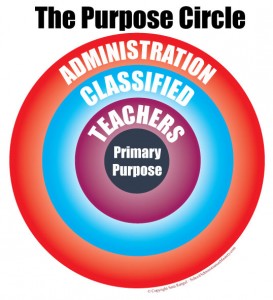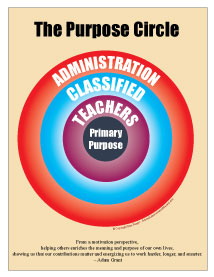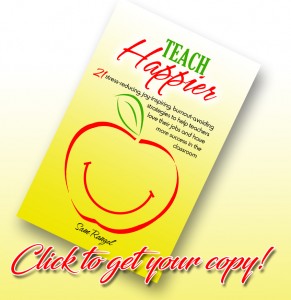“From a motivation perspective, helping others enriches the meaning and purpose of our own lives, showing us that our contributions matter and energizing us to work harder, longer, and smarter.” – Adam Grant
Being a school administrator is tough.
You have a vision for the school. You have goals and objectives that you want to reach. The only problem is that you can’t be successful by yourself. You need your staff to pitch in and work collaboratively to get to where you want to go.
That’s the key work: “Collaboratively.”
Wouldn’t it be great if every member of your staff worked collaboratively to meet the needs of the students?
Your life would be so much easier. Right?
As any school administrator will tell you, creating that collaborative culture is difficult. Some staff members are willing to roll up their sleeves and get working with the team, while others are more reluctant. Some staff members seem to be rowing in the opposite direction, and they keep the school from moving forward.
Anybody know what I’m talking about?
It’s easy to place blame on those reluctant staff members, and just throw up our hands and just wait for them to retire. Successful school administrators, however, don’t place blame, but rather ask themselves what can they do to create change.
That is why after much research, I developed the Purpose Circle.
The Purpose Circle
The Purpose Circle a visual representation of what I have found to be beneficial in clarifying how a school, or actually any organization, can function more collaboratively and with fewer conflicts.
The Purpose Circle has helped to clarify my role as a school leader, and it has changed the way I do my job.
I wanted to share a quick overview of this concept here in this post. I hope to explain it in more detail in future posts.
The Center
There are four different layers to the Purpose Circle.
In the center is the school’s Primary Purpose.
What is the Primary Purpose of the school?
This is the question that must be answered first, and it has to be clear, especially to the school administrator. Why does the school exist? What is its Primary Purpose?
Take a little time to consider this question. How would you answer it?
After thinking about it for a while, here is what I have determined to be the Primary Purpose of my school, and probably every school:
The Primary Purpose of the school is to prepare students for success academically, socially and emotionally.
Would you agree with this Primary Purpose statement? I suppose it can be written in a different way, but for the sake of this post, let’s go with this one. It’s simple and to the point.
So, in the middle of the Purpose Circle, is our Primary Purpose.
Layer One
The next question is:
Which members of your staff have the most direct connection with the Primary Purpose? That is, which school employees are directly involved in preparing students for success academically, socially, and emotionally?
The head custodian? The principal’s secretary? The principal? No.
Teachers have that access. Right?
Teachers have the specific training and expertise to achieve the Primary Purpose.
Because they have that training and expertise, we entrust our students to them, and we expect them to use those skills and abilities to prepare our students for success through their daily lessons and activities.
Teachers, then, go in the first circle around the center.
Reflection Question: Do your teachers know what the Primary Purpose of the school is, or do we just assume they know?
Layer Two
In the next circle, we place the classified staff. These members of our staff are essential to the successful operation of our schools, but they do not directly prepare our students for success academically, socially and emotionally. This doesn’t mean that they don’t contribute to preparing students for success. It just means that their contribution is more indirect than direct.
Reflection Question: Does your classified staff know what the Primary Purpose of the school is?
Layer Three
In the third ring of our Purpose Circle is the administration. That’s us.
I know that it is easy to get caught up in the daily demands placed on us – pass/fail rates, behavior statistics, maintenance concerns, state and district assessments, parent feedback, school branding, staffing, master schedule, etc.
The Purpose Circle, however, helps to strip away the layers of our administrator lives, and it causes us to focus on the basic, fundamental purpose of why we do what we do. Everything we do needs to be connected to our Primary Purpose – preparing our students for success.
For us to be successful in our roles as school leaders, we must be able to connect what the members of our staff do on a daily basis to the school’s Primary Purpose.
Administrators are Purpose Connectors.
How is what the Attendance Clerk does on a daily basis connected to preparing students for success?
What about the school nurse? How does her job connect to preparing students for success?
With a little creative mapping, you can show them how what they do helps kids be successful. Right?
Decreased motivation and even conflicts can arise when people at each level of the Purpose Circle lose focus of the school’s Primary Purpose.
It’s easy to lose focus. There are a lot of demands placed on the various members of the staff.
That’s where we as school leaders must intervene. We need to:
- Continually remind staff at each level in the Purpose Circle of the Primary Purpose.
- Continually connect what staff members do to the Primary Purpose.
- Continually acknowledge and reward staff at each level of the Purpose Circle when their actions help to meet the Primary Purpose.
- Hold staff at each level of the Purpose Circle accountable when their actions are contrary to meeting the Primary Purpose.
When we do this, we bring meaning to what teachers and classified staff do each day.
But wait there’s more…
An important point to recognize is that the Primary Purpose of the school is a good purpose. It’s a noble purpose. Studies show that people will work harder and happier if they know that what they do is part of a greater, more noble purpose. Helping kids is good, and most people will give their best effort when they know that their sacrifice is to help kids. The problem is that in most cases, unless we are reminded that our efforts are for a good cause, we really have no reason to give any more effort than necessary to comply with our job description.
For this reason, it is so important that we, as school administrators, make it an intentional part of our days to keep the school’s Primary Purpose in the minds of our staff members. Imagine how collaborative some of our staff would be if they were motivated by the noble purpose of helping kids be successful instead of just the paycheck?
I hope this post was helpful in clarifying how we can help improve collaboration and reduce the conflicts in our schools. I know it has cleared things up for me. It has also allowed me to begin to add this Primary Purpose message to my daily conversations with my teachers and classified staff, and the results have been encouraging. Recently, I thanked a custodian for his attention to detail in cleaning classrooms. I explained to him that by giving teachers a clean environment in which to teach, he is indirectly helping us achieve our Primary Purpose – preparing students for success. He had never really seen it that way. How cool is that?
If you found the Purpose Circle valuable, please share this post with your fellow school administrators.
Until next time, here’s to our journey toward School Administration Mastery!
Thank you,
Sam



